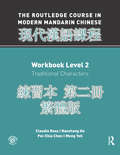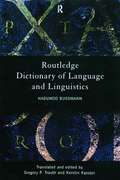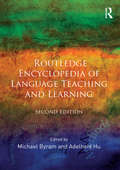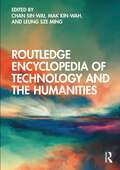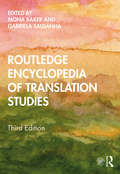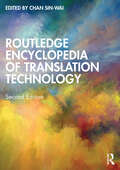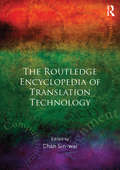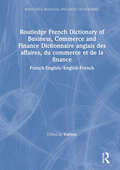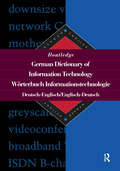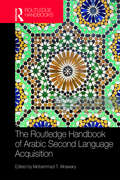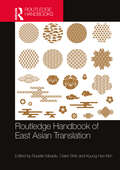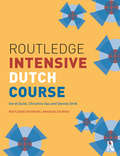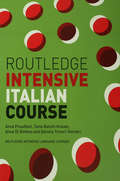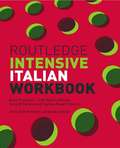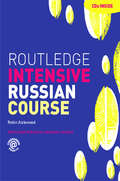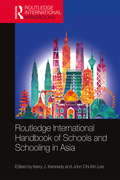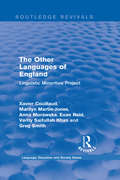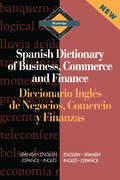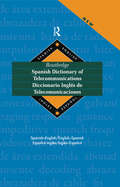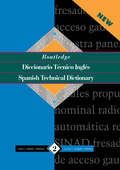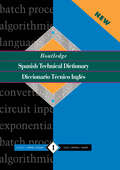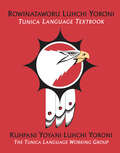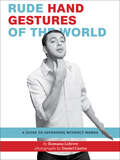- Table View
- List View
Routledge Course in Modern Mandarin Chinese Workbook 2 (Traditional)
by Claudia Ross Baozhang He Pei-Chia Chen Meng YehThe Routledge Course in Mandarin Chinese is a two-year undergraduate course for students with no prior background in Chinese study. Designed to build a strong foundation in both the spoken and written language it develops all the basic skills such as pronunciation, character writing, word use and structures, while placing strong emphasis on the development of communicative skills. The complete course consists of Textbook Level 1, Workbook level 1 - including free CDs, Textbook level 2 and Workbook level 2 -including free CDs. All books are available separately in simplified as well as traditional characters and take the students from complete beginner to post-intermediate level. For more information about the course and additional resources, please visit the companion website at www.routledge.com/textbooks/9780415472517 Workbook Level 2 is designed to accompany Textbook Level 2 lesson by lesson, and offers exercises for homework, independent study and classroom use. The exercises focus on interpersonal, interpretative and presentational modes of communication while helping students to consolidate the vocabulary, characters, and structures introduced in each lesson. At the conclusion of this course, students will be able to read page-length texts for information, listen to and comprehend extended narratives on a variety of topics, and communicate a broad range of information orally and in writing. The course is also fully supported by an interactive companion website which contains a wealth of additional resources for both teachers and students. Teachers will find lesson plans in both English and Mandarin, providing a weekly schedule and overall syllabus for fall and spring, as well as activities for each lesson and answer keys. Students will be able to access downloadable character practice worksheets along with interactive pronunciation, vocabulary and character practice exercises. All the audio material necessary for the course is also available online and conveniently linked on screen to the relevant exercises for ease-of-use. For more information about the course and to access these additional resources, please visit the companion website at www.routledge.com/textbooks/9780415472517 For bundle discounts please visit: http://www.routledge.com/books/details/9780415533089/
Routledge Dictionary of Language and Linguistics
by Hadumod BussmannThe Routledge Dictionary of Language and Linguistics is a unique reference work for students and teachers of linguistics. The highly regarded second edition of the Lexikon der Sprachwissenschaft by Hadumod Bussmann has been specifically adapted by a team of over thirty specialist linguists to form the most comprehensive and up-to-date work of its kind in the English language. In over 2,500 entries, the Dictionary provides an exhaustive survey of the key terminology and languages of more than 30 subdisciplines of linguistics. With its term-based approach and emphasis on clear analysis, it complements perfectly Routledge's established range of reference material in the field of linguistics.
Routledge Encyclopedia of Language Teaching and Learning
by Michael Byram Adelheid HuThe Routledge Encyclopedia of Language Teaching and Learning is an authoritative reference dealing with all aspects of this increasingly important field of study. Offering a comprehensive range of articles on contemporary language teaching and its history, it has been produced specifically for language teaching professionals and as a reference work for academic studies at postgraduate level. In this new edition, every single entry has been reviewed and updated with reference to new developments and publications. Coverage has been expanded to reflect new technological, global and academic developments, with particular attention to areas such as online and distance learning, teacher and learner cognition, testing, assessment and evaluation, global English and teacher education. Themes and disciplines covered include: Methods and materials, including new technologies and materials development Contexts and concepts, such as mediation, risk-taking in language learning and intercomprehension Influential figures from the early days of language teaching to the contemporary Related disciplines, such as psychology, anthropology and corpus linguistics It covers the teaching of specific languages, including Japanese, Chinese, Arabic and African languages, as well as English, French, German and Spanish. There are thirty five overview articles dealing with issues such as communicative language teaching, early language learning, teacher education and syllabus and curriculum design. A further 160 entries focus on topics such as bilingualism, language laboratories and study abroad. Numerous shorter items examine language and cultural institutions, professional associations and acronyms. Multiple cross-references enable the user to browse from one entry to another, and there are suggestions for further reading. Written by an international team of specialists, the Routledge Encyclopedia of Language Teaching and Learning is an invaluable resource and reference manual for anyone with a professional or academic interest in the subject.
Routledge Encyclopedia of Technology and the Humanities
by Chan Sin-Wai Mak Kin-Wah Leung Sze MingRoutledge Encyclopedia of Technology and the Humanities is a pioneer attempt to introduce a wide range of disciplines in the emerging field of techno-humanities to the English-reading world.This book covers topics such as archaeology, cultural heritage, design, fashion, linguistics, music, philosophy, and translation. It has 20 chapters, contributed by 26 local and international scholars. Each chapter has its own theme and addresses issues of significant interest in the respective disciplines. References are provided at the end of each chapter for further exploration into the literature of the relevant areas. To facilitate an easy reading of the information presented in this volume, chapters have been arranged according to the alphabetical order of the topics covered.This Encyclopedia will appeal to researchers and professionals in the field of technology and the humanities, and can be used by undergraduate and graduate students studying the humanities.
Routledge Encyclopedia of Translation Studies
by Mona Baker Gabriela SaldanhaThe Routledge Encyclopedia of Translation Studies remains the most authoritative reference work for students and scholars interested in engaging with the phenomenon of translation in all its modes and in relation to a wide range of theoretical and methodological traditions. This new edition provides a considerably expanded and updated revision of what appeared as Part I in the first and second editions. Featuring 132 as opposed to the 75 entries in Part I of the second edition, it offers authoritative, critical overviews of additional topics such as authorship, canonization, conquest, cosmopolitanism, crowdsourced translation, dubbing, fan audiovisual translation, genetic criticism, healthcare interpreting, hybridity, intersectionality, legal interpreting, media interpreting, memory, multimodality, nonprofessional interpreting, note-taking, orientalism, paratexts, thick translation, war and world literature. Each entry ends with a set of annotated references for further reading. Entries no longer appearing in this edition, including historical overviews that previously appeared as Part II, are now available online via the Routledge Translation Studies Portal. Designed to support critical reflection, teaching and research within as well as beyond the field of translation studies, this is an invaluable resource for students and scholars of translation, interpreting, literary theory and social theory, among other disciplines.
Routledge Encyclopedia of Translation Technology
by Chan Sin-WaiRoutledge Encyclopedia of Translation Technology, second edition, provides a state-of-the-art survey of the field of computer-assisted translation. It is the first definitive reference to provide a comprehensive overview of the general, regional, and topical aspects of this increasingly significant area of study. The Encyclopedia is divided into three parts: Part 1 presents general issues in translation technology, such as its history and development, translator training, and various aspects of machine translation, including a valuable case study of its teaching at a major university; Part 2 discusses national and regional developments in translation technology, offering contributions covering the crucial territories of China, Canada, France, Hong Kong, Japan, South Africa, Taiwan, the Netherlands and Belgium, the United Kingdom, and the United States; Part 3 evaluates specific matters in translation technology, with entries focused on subjects such as alignment, concordancing, localization, online translation, and translation memory. The new edition has five additional chapters, with many chapters updated and revised, drawing on the expertise of over 50 contributors from around the world and an international panel of consultant editors to provide a selection of chapters on the most pertinent topics in the discipline. All the chapters are self-contained, extensively cross-referenced, and include useful and up-to-date references and information for further reading. It will be an invaluable reference work for anyone with a professional or academic interest in the subject.
Routledge Encyclopedia of Translation Technology
by Chan Sin-WaiRoutledge Encyclopedia of Translation Technology, second edition, provides a state-of-the-art survey of the field of computer-assisted translation. It is the first definitive reference to provide a comprehensive overview of the general, regional, and topical aspects of this increasingly significant area of study. The Encyclopedia is divided into three parts: Part 1 presents general issues in translation technology, such as its history and development, translator training, and various aspects of machine translation, including a valuable case study of its teaching at a major university; Part 2 discusses national and regional developments in translation technology, offering contributions covering the crucial territories of China, Canada, France, Hong Kong, Japan, South Africa, Taiwan, the Netherlands and Belgium, the United Kingdom, and the United States; Part 3 evaluates specific matters in translation technology, with entries focused on subjects such as alignment, concordancing, localization, online translation, and translation memory. The new edition has five additional chapters, with many chapters updated and revised, drawing on the expertise of over 50 contributors from around the world and an international panel of consultant editors to provide a selection of chapters on the most pertinent topics in the discipline. All the chapters are self-contained, extensively cross-referenced, and include useful and up-to-date references and information for further reading. It will be an invaluable reference work for anyone with a professional or academic interest in the subject.
Routledge Encyclopedia of Translation Technology
by Sin-Wai ChanThe Routledge Encyclopedia of Translation Technology provides a state-of-the art survey of the field of computer-assisted translation. It is the first definitive reference to provide a comprehensive overview of the general, regional and topical aspects of this increasingly significant area of study. The Encyclopedia is divided into three parts: Part One presents general issues in translation technology, such as its history and development, translator training and various aspects of machine translation, including a valuable case study of its teaching at a major university; Part Two discusses national and regional developments in translation technology, offering contributions covering the crucial territories of China, Canada, France, Hong Kong, Japan, South Africa, Taiwan, the Netherlands and Belgium, the United Kingdom and the United States Part Three evaluates specific matters in translation technology, with entries focused on subjects such as alignment, bitext, computational lexicography, corpus, editing, online translation, subtitling and technology and translation management systems. The Routledge Encyclopedia of Translation Technology draws on the expertise of over fifty contributors from around the world and an international panel of consultant editors to provide a selection of articles on the most pertinent topics in the discipline. All the articles are self-contained, extensively cross-referenced, and include useful and up-to-date references and information for further reading. It will be an invaluable reference work for anyone with a professional or academic interest in the subject.
Routledge French Dictionary of Business, Commerce and Finance Dictionnaire anglais des affaires, du commerce et de la finance: French-English/English-French (Routledge Bilingual Specialist Dictionaries)
by VariousThis dictionary consists of some 100,000 terms and references in bith French and English, including 4,000 abbreviations. over 45 subject areas are covered, including: * Accountancy * Banking * Business Administration * Computing * Economics * Environment * Finance * General Commerce * Human Resource Management * Import/Export * Industry * Insurance * Law * Leisure * Management * Mathematics * Media * Patents * Politics * Property * Sales & Marketing * Stock Market * Taxation * Tourism * Transport * Welfare & Safety. Also included is a comprehensive up-to-date reference section on countries, business correspondence and situations, job titles, stock exchanges, economic indexes and numbers.KEY FEATURESTerm Specialists - the terms list has been checked by over 100 sources including experts from Apple France * Association Française des Banques * Chartered Institute of Banking * France Telecom * Institute of European Trade and Technology * American Graduate School of Management * London School of Economics * Ecole supérieure de commerce de Lyon * Department of Trade and Industry * Law Society * University of Reading * Environment Council * University of Bath * Centre de Recherche et de Gestion * Manchester Business School * Ecole supérieure internationale de commerce and Ecole des hautes études commerciales de Montrial(HEC).Prestigous experts - include Prof. Chris Nobes, Prof. Michel Péron, Prof. Gordon Shenton, Dr. Van de Yeught and Prof. Peter Walton.Native Speakers - all stages of compilation have included native speakers of French as well as English and extensive coverage of US as well as UK terminology.
Routledge German Dictionary of Information Technology Worterbuch Informationstechnologie: German-English/English-German (Routledge Bilingual Specialist Dictionaries)
by Sinda LópezThis thorough reference source is in-dispensible for translators working in the realms of artificial intelligence, computing, data processing, physics, online services and related disciplines. The dictionary also features hot translation links, indexed cross-references for easy, rapid access, and an intuitive screen environment while covering the most up-to-date terminology in this cutting edge subject area. Diese umfassende Referenzquelle ist für Übersetzer, die in den Bereichen künstliche Intelligenz, Informatik, Datenverarbeitung, Physik, Online-Dienste und verwandten Disziplinen arbeiten, unverzichtbar. Das Wörterbuch verfügt außerdem über „Hot Translation“-Links, indizierte Querverweise für einen einfachen und schnellen Zugriff sowie eine intuitive Bildschirmumgebung und deckt gleichzeitig die aktuellste Terminologie in diesem hochmodernen Themenbereich ab.
Routledge Handbook of Arabic Second Language Acquisition (Routledge Language Handbooks)
by Mohammad T. AlhawaryThe Routledge Handbook of Arabic Second Language Acquisition introduces major current approaches in Arabic second language acquisition (SLA) research and offers empirical findings on crucial aspects and issues to do with the learning of Arabic as a foreign language and Arabic SLA. It brings together leading academics in the field to synthesize existing research and develops a new framework for analyzing important topics within Arabic SLA. This handbook will be suitable as a reference work for advanced undergraduate and postgraduate students and scholars actively researching in this area and is primarily relevant to sister disciplines within teacher training and Arabic applied linguistics. The themes and findings should, however, also be attractive to other areas of study, including theoretical linguistics, psycholinguistics, cognition, and cognitive psychology.
Routledge Handbook of East Asian Translation (Routledge Studies in East Asian Translation)
by Kyung Hye Kim Ruselle Meade Claire ShihRoutledge Handbook of East Asian Translation showcases new research and developments in translation studies within the East Asian context.This handbook draws attention to the diversity of scholarship on translation in East Asia, and its relevance to a variety of established and emerging fields. It focuses on hitherto less-explored interactions, such as intra-Asian translation encounters, translation of minority languages, and translation between East Asian and non-European languages, while also contributing to a thriving body of historical scholarship on East Asian translation traditions. Contributions reflect a growing awareness of the cultural and linguistic heterogeneity within nations, and the reality of multilingualism and plurilingualism among many communities in East Asia. A wide variety of translatorial practices are discussed, including the creative use of Chinese in Japanese-language novels, the use of translation to evade censorship online, community theatre translation, and translation of picture books. The volume also includes contributions by practitioners, who reflect on their experiences of translation and of developing training programmes for community interpreters.This handbook will appeal to researchers and students of translation and interpreting studies. Chapters are likely to be of value to those working, not only in East Asian studies, but also disciplines such as literary studies, global cultural studies, and LGBT+ studies.
Routledge Intensive Dutch Course (Routledge Intensive Language Courses)
by Christine Sas Gerdi Quist Dennis StrikThis intensive foundation course in Dutch is designed for those with no previous knowledge of the language. It is lively and fast-paced, providing students with a wide range of activities, and drawing on an impressive selection of source material from many different media. Audio materials are presented on accompanying CDs, to be purchased separately. Taking students from beginner to intermediate level in one year, the Routledge Intensive Dutch Course develops a thorough working knowledge of the structures of Dutch and practises the four key skills of language learning: reading, writing, speaking, and listening. Guidance for tutors as well as links to related sites is available on the Routledge website.
Routledge Intensive Italian Course (Routledge Intensive Language Courses)
by Anna Proudfoot Tania Batelli Kneale Daniela Treveri Gennari Anna Di StefanoThis intensive foundation course in Italian is designed for students with no previous knowledge of the language. Accompanying audio material containing dialogues, listening exercises and pronunciation practice is available to listen to here www.routledge.com/9780415240802. The audio is designed to work alongside the accompanying book. Students using the Routledge Intensive Italian Course will practise the four key skills of language learning - reading, writing, speaking, and listening - and will acquire a thorough working knowledge of the structures of Italian. The Routledge Intensive Italian Course takes students from beginner to intermediate level in one year.
Routledge Intensive Italian Workbook (Routledge Intensive Language Courses)
by Anna Proudfoot Tania Batelli Kneale Daniela Treveri Gennari Anna Di StefanoThe Routledge Intensive Italian Workbook is a comprehensive book of exercises and tasks for beginner and intermediate learners of Italian.It includes a wide variety of exercises - covering a broad range of situations and functions - and will help students to progress rapidly and master the language accurately. Students can check their own progress using the answer key. The Workbook can be used independently, or in conjunction with the Routledge Intensive Italian Course, an accelerated course in Italian for adult beginners, which is accompanied by audio material.
Routledge Intensive Russian Course (Routledge Intensive Language Courses)
by Robin AizlewoodThis intensive foundation course in Russian is designed for students with no previous knowledge of the language. Developed primarily for classroom use, the course offers an original and distinctive approach to language learning, presenting Russian in context offering access to Russian life, culture, history and society. Using authentic language throughout, the course takes students from beginner to intermediate level in one year. Progress is carefully structured, starting with simple grammar and working towards more complex points with the acquisition of a significant body of vocabulary. By the end of the course students will have acquired a sound knowledge of the main structures of the language and will be able to express themselves confidently in a wide range of communicative contexts. The tried-and-tested material featured in the course is structured to improve all four core skills of language learning: speaking, listening, reading and writing. The course is divided in three parts: Part 1 provides a foundation which gets the student going in Russian Part 2 concentrates on intensive development to take the student rapidly forward Part 3 incorporates both revision and further development. Each unit is divided into lessons which all include lively dialogues, sections on grammar and language functions and lots of exercises that help develop the student's practical language skills. Audio materials recorded by native speakers include dialogues, exercises and a variety of texts to help students using the course to improve their listening comprehension and pronunciation skills. Audio materials recorded by native speakers include dialogues, exercises and a variety of texts to help students using the course to improve their listening comprehension and pronunciation skills. The audio materials and other supplementary materials are available as free eResources here: www.routledge.com/9780415223003.
Routledge International Handbook of Schools and Schooling in Asia (Routledge International Handbooks)
by John Chi-Kin Lee Kerry J. KennedyThis comprehensive handbook is the ultimate reference work, providing authoritative and international overviews of all aspects of schools and schooling in Asia. Split into 19 sections it covers curriculum, learning and assessment, private supplementary tutoring, special education, gender issues, ethnic minority education and LGBTQI students in Asian schools. The volume displays the current state of the scholarship for schools and schooling in Asia including emerging, controversial and cutting-edge contributions using a thematic approach. The content offers a broad sweep of the region with a focus on theoretical, cultural and political issues as well as identifying educational issues and priorities, such as curriculum, assessment, teacher education, school leadership, etc., all of which impact students and learning in multiple ways. The Routledge International Handbook of Schools and Schooling in Asia brings together experts in each area to contribute their knowledge, providing a multidimensional and rich view of the issues confronting the region’s school and education systems.
Routledge Revivals: Linguistic Minorities Project (Routledge Revivals: Language, Education and Society Series #2)
by Greg Smith Xavier Couillaud Marilyn Martin-Jones Anna Morawska Euan Reid Verity Saifullah KhanThe ‘other’ languages of England — those which originate in South and East Asia, and Southern and Eastern Europe — are now important parts of everyday life in urban England. First published in 1985, this book gives detailed information about which languages are in widespread use among children and adults, patterns of language use in different social contexts, the teaching of these community languages inside and outside of mainstream schools, and the educational implications of this linguistic diversity for all children in England. They authors argue that this continued and widespread bilingualism is a valuable potential resource for both the speakers and society as a whole.
Routledge Spanish Dictionary of Business, Commerce and Finance Diccionario Ingles de Negocios, Comercio y Finanzas: Spanish-English/English-Spanish (Routledge Bilingual Specialist Dictionaries)
by Emilio G. CastroThis Dictionary consists of some 100,000 terms in both Spanish and English, drawn from the whole range of business, finance and banking terminology. Over 45 subject areas are covered, compiled by a team of international terminologists
Routledge Spanish Dictionary of Telecommunications Diccionario Ingles de Telecomunicaciones: Spanish-English/English-Spanish (Routledge Bilingual Specialist Dictionaries)
by Emilio G. CastroThis dictionary consists of some 25,000 terms and references in both Spanish and English, drawn from all the major areas in the field of Telecommunications. It includes comprehensive labelling of subject areas, detailed abbreviation entries including cross-reference links to full forms, full British and American English coverage of lexical and spelling variants presented in clear layout and typography. Este diccionario consta de unos 25.000 términos y referencias tanto en español como en inglés, procedentes de las principales áreas del campo de las Telecomunicaciones. Incluye etiquetado completo de áreas temáticas, entradas de abreviaturas detalladas que incluyen enlaces de referencia cruzada a formularios completos, cobertura completa en inglés británico y americano de variantes léxicas y ortográficas presentadas en un diseño y tipografía claros.
Routledge Spanish Technical Dictionary Diccionario tecnico inges: Volume 2: English-Spanish/ingles-Espanol (Routledge Bilingual Specialist Dictionaries)
by 0 Routledge,These 2 volumes consist of some 100,000 headwords in both Spanish and English, including 3,000 abbreviations. Terms are drawn from the whole range of modern applied science and technical terminology. These volumes can be purchased either separately or together in print. Each volume is compiled by an international team of subject terminologists, native English and Spanish speakers. Special attention is given to differences between UK and US terminology, and to Spanish and Latin-American variants. Over 70 subject areas are covered. Estos 2 volúmenes constan de unos 100.000 lemas tanto en español como en inglés, incluidas 3.000 abreviaturas. Los términos se extraen de toda la gama de terminología técnica y científica aplicada moderna. Estos volúmenes se pueden comprar por separado o juntos en forma impresa. Cada volumen es compilado por un equipo internacional de terminólogos temáticos, hablantes nativos de inglés y español. Se presta especial atención a las diferencias entre la terminología del Reino Unido y Estados Unidos, y a las variantes española y latinoamericana. Se cubren más de 70 áreas temáticas.
Routledge Spanish Technical Dictionary Diccionario tecnico ingles: Volume 1: Spanish-English/ingles-espanol (Routledge Bilingual Specialist Dictionaries)
by Sinda LópezThese 2 volumes consist of some 100,000 headwords in both Spanish and English, including 3,000 abbreviations. Terms are drawn from the whole range of modern applied science and technical terminology. These volumes can be purchased either separately or together in print. Each volume is compiled by an international team of subject terminologists, native English and Spanish speakers. Special attention is given to differences between UK and US terminology, and to Spanish and Latin-American variants. Over 70 subject areas are covered. Estos 2 volúmenes constan de unos 100.000 lemas tanto en español como en inglés, incluidas 3.000 abreviaturas. Los términos se extraen de toda la gama de terminología técnica y científica aplicada moderna. Estos volúmenes se pueden comprar por separado o juntos en forma impresa. Cada volumen es compilado por un equipo internacional de terminólogos temáticos, hablantes nativos de inglés y español. Se presta especial atención a las diferencias entre la terminología del Reino Unido y Estados Unidos, y a las variantes española y latinoamericana. Se cubren más de 70 áreas temáticas.
Rowinataworu Luhchi Yoroni / Tunica Language Textbook
by Kuhpani Yoyani Luhchi Yoroni / The Tunica Language Working GroupThe essential guide for learning the Tunica language.For many years, the Tunica-Biloxi Tribe of Louisiana collaborated with students and faculty at Tulane University on a project to revitalize the Tunica language. Tunica had not been spoken or used regularly in the community since the last known speaker, Sesostrie Youchigant, passed away in 1948. The center of the revitalization of the Tunica language is this first-of-its-kind, beginning Tunica language textbook.The Tunica Language Textbook (Rowinataworu Luhchi Yoroni) contains everything needed to become conversationally fluent in Tunica. Like other language textbooks, it contains vocabulary and grammatical information, as well as practice exercises that develop both comprehension and production of Tunica, and acquisition of the patterns, not just the forms. The textbook contains links to an online pronunciation guide and includes a wealth of information on cultural topics, from stickball to basketry to naming to cosmology, and uses the language to do so. Wherever possible, excerpts from the original documentation of Tunica stories and myths have been included, so that students can become acquainted with native-like language use.Each chapter is structured to lead the student through the stages of learning, from presentation of new information, to recognition, to identification, to application. While there is explanation of the topics in English, the lessons are designed to be used in an immersion classroom setting as well as for individual use.
Ruchira
by National Council Of Educational Research TrainingThis book prescribed by central board of secondary education, India for the students of class 7th subject Sanskrit, studying through hindi medium. This accessible version of the book doesn’t leave any part of the book. The book is handy companion of the school and university students desiring to read facts in interesting way. NCERT books are must read for aspirants of competitive and job related examinations in India.
Rude Hand Gestures of the World: A Guide To Offending Without Words
by Romana LefevreWith this illustrated guide, discover what hand gestures can offend others around the world—and whether you avoid making them or not is up to you.A hand gesture is arguably the most effective form of expression, whether you’re defaming a friend’s mother or telling a perfect stranger to get lost. Learn how to go beyond just flipping the bird with this illustrated guide to rude hand gestures all around the world, from asking for sex in the Middle East to calling someone crazy in Italy. Detailed photographs of hand models and subtle tips for proper usage make Rude Hand Gestures of the World the perfect companion for globe-trotters looking to offend.“If you’ve resolved to make the most of your travels, a copy of Rude Hand Gestures of the World to know what gestures you should avoid while abroad. Better safe than sorry!” —Buzzfeed
